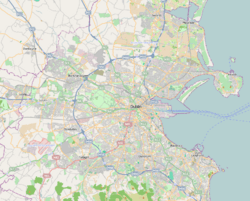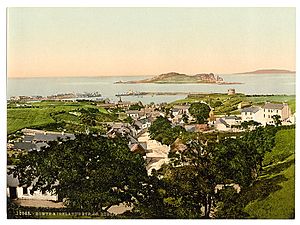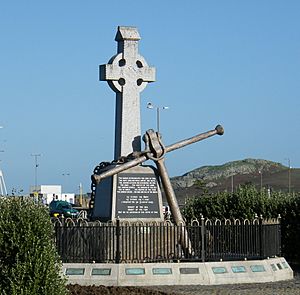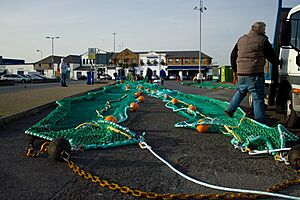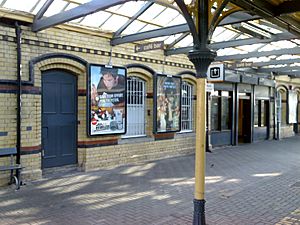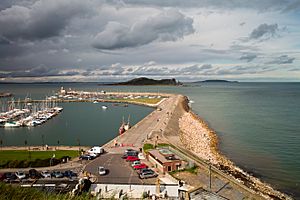Howth facts for kids
Quick facts for kids
Howth
Binn Éadair
|
|
|---|---|
|
Village and district
|
|

Aerial photo of Howth and harbour
|
|
| Country | Ireland |
| Province | Leinster |
| County | Dublin |
| Administrative County | Fingal |
| Highest elevation | 171 m (561 ft) |
| Lowest elevation | 0 m (0 ft) |
| Population
(2016)
|
|
| • Urban | 8,277 |
| Time zone | UTC±0 (WET) |
| • Summer (DST) | UTC+1 (IST) |
| Eircode routing key |
D13
|
| Telephone area code | +353(0)1 |
Howth ( HOHTH; Irish: Binn Éadair, meaning Éadar's peak) is a lovely village and outer suburb of Dublin, Ireland. It sits on most of the Howth Head peninsula. This peninsula forms the northern edge of Dublin Bay.
People have lived in Howth since ancient times. It even appears in old Irish stories! Howth started as a fishing village and small trading port many centuries ago. Today, it is a busy and lively suburb of Dublin. It has homes, wild hills, golf courses, and beautiful coastal paths. Howth also has a busy fishing port. The only nearby area on land is Sutton. Howth is also home to Howth Castle, one of Ireland's oldest buildings still in use.
Howth is also a civil parish in the old barony of Coolock.
Contents
Where is Howth?
Howth is on the peninsula of Howth Head. This land sticks out into the sea about 13 kilometers (8 miles) east of Dublin. It is on the north side of Dublin Bay. The village itself is about 15 kilometers (9 miles) from Dublin city center. Howth Head was once an island. Now, a narrow strip of land connects it to Dublin at Sutton. Howth is part of the Fingal county area.
You can reach Howth by road using the R105 road. It is also one of the last stops on the DART train system. Dublin Bus routes 31, 31a, and 31b also serve Howth.
Besides its fishing harbor, Howth has a large marina for boats. You can also take a seasonal boat trip to Ireland's Eye, an island nearby.
What Does "Howth" Mean?
The Irish name for Howth is Binn Éadair. This means "Éadar's Peak" or "Éadar's Hill." In Old Irish, it was called Etar. Vikings first raided this area around 819 AD.
The name Howth likely comes from the Old Norse word Hǫfuð. This word means "head" in English. Norse vikings settled on Ireland's eastern shores. They built a base called Dyflinn, which later became part of Dublin.
Howth's Past: A Quick Look
An old map from the 2nd century by Ptolemy shows Howth as an island. It was called Edri Deserta then.
Early History: Vikings and Normans
In 1014, Brian Ború, the High King of Ireland, defeated the Norse. Many Norse people fled to Howth to regroup. They remained a strong group until the mid-11th century. Howth stayed under Irish and local Norse control. This changed when the Anglo-Normans invaded Ireland in 1169.
Howth was isolated and fell to the Normans in 1177. A Norman leader named Armoricus Tristram won much of the land. His family, later known as St. Lawrence, owned the land until 2019. Tristram built his first castle overlooking the harbor. The first Baron of Howth title was given to Almeric St. Lawrence in 1181.
Howth was a small trading port from the 14th century. The main harbor was not built until the early 1800s.
The Story of Grace O'Malley
A famous story tells of Grace O'Malley, a clan leader and pirate. In 1576, she tried to visit Howth Castle. But she was turned away! In return, she kidnapped the Earl's grandson. To get him back, she made the Earl promise two things. First, unexpected guests would always be welcome. Second, the gates of Deer Park, the Earl's land, would never be closed. To this day, the gates are still open. An extra place is even set for unexpected guests at formal dinners!
The 19th Century and Beyond
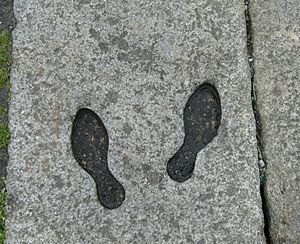
In the early 1800s, Howth was chosen for the mail packet ship harbor. This was for postal services. But the harbor often filled with silt, needing constant cleaning. So, the service moved to Dún Laoghaire. King George IV visited the harbor in August 1821.
On July 26, 1914, 900 rifles were brought to Howth. Erskine Childers landed them for the Irish Volunteers. Many of these rifles were used in the Easter Rising and the Irish War of Independence. Local people from Howth were very involved in these events.
The harbor was greatly rebuilt in the late 20th century. It now has separate areas for fishing and leisure boats. A modern ice-making plant was added. Howth is also home to the RNLI (lifeboat service) and the Irish Coastguard.
In 2019, Howth Castle and its lands were sold. This included Ireland’s Eye.
Nature in Howth
Natural Features and Protected Areas
Howth Head is a main feature of Dublin Bay. It has several peaks, with Black Linn being the highest. There is a small peat bog called the "Bog of the Frogs." You can explore the wilder parts of Howth using many paths. Much of the area is protected as a Special Area of Conservation. It is also protected by a Special Amenity Area Order.
The peninsula has many small, fast-flowing streams. Three of these streams run through the village. The island of Ireland's Eye is about one kilometer (0.6 miles) north of Howth harbor. Lambay Island is about 5 kilometers (3 miles) further north.
You can find Martello towers on both islands. Another tower overlooks Howth harbor. This tower is now a visitor center and museum. These towers were built around Ireland's coast in the 19th century.
Special Amenity Area Order: Protecting Howth
More than half of Howth Head, about 1,500 acres, is protected. This is thanks to a Special Amenity Area Order. This Irish law helps protect beautiful natural areas. The order was made in 1999 to stop too much building. It also aims to encourage tourism in other parts of Howth.
The protected area includes many hills, the Summit, and Ireland's Eye. It also covers over 20 kilometers (12 miles) of walking paths. All scenic views from these paths and roads are protected.
Fingal County Council explained why this order was needed. Howth changed from a rural area to a Dublin suburb. Its natural areas shrank from over 70% to about 40%. This order helps keep Howth's natural beauty safe.
Animals and Plants of Howth
Howth is a unique area, so its plants and animals have been studied a lot. A book called Flora of Howth was even published in 1887.
It's a great place for birdwatching and sailing. Many people also enjoy fishing here. You can catch fish like cod and ray from the rocky shores. Sea mammals, like seals, are often seen near the harbor. It used to be popular to feed the seals, but this is now not allowed for their safety.
Many birds live here, including razorbills, guillemots, and cormorants. You might also spot peregrine falcons, buzzards, and kestrels.
Historic Buildings and Sites
Howth Castle and its land, called Deer Park, are very important to the area. On the castle grounds, you can find a fallen dolmen. This ancient tomb is known as Aideen's Grave. Corr Castle was also once part of the estate.
At the southeast tip of Howth Head is the Baily Lighthouse. This lighthouse helps guide ships. At the end of Howth Harbor's East Pier is the Howth Harbour Lighthouse. It was built in the 19th century but is no longer used.
In Howth village, you'll find St. Mary's Church and its graveyard. The first church here was built in 1042. The current church was built in the 14th century. The St. Lawrence family from Howth Castle used the east end as their private chapel. Inside is the tomb of Christopher St Lawrence, who died in 1462.
Another old building is The College or The Old College on Abbey Street. It was built in the late 1400s or early 1500s.
Things to Do and See
Howth is still a busy fishing port. It is one of Ireland's main fishing centers. Fish are processed in the harbor area. There is also a State Fisheries Centre with an ice-making plant.
The area has many shops and places to eat. You can find many restaurants and a post office. The nearest supermarket is in Sutton Cross.
Howth used to have many hotels. The last one, the Deer Park Hotel, closed in 2014. However, its bar and golf courses are still open. There are also many bed-and-breakfast places. The closest working hotel is The Marine Hotel in Sutton Cross.
Howth is also home to the Olympic Council of Ireland.
Fun Activities in Howth
Many tourists visit Howth each year. They come to enjoy the amazing views from the summit. They also walk along the piers and try fresh local seafood.
Howth is a great spot for birdwatching and sailing. It is also popular with people who love to fish. You can often see seals in and near the harbor.
Howth is a favorite place for cyclists, joggers, and hikers. Especially on weekends, the trails are busy. One popular walk is the six-kilometer (3.7 miles) Cliff Path Loop. This walk takes about two hours and is easy to moderate. It starts and ends at the Howth DART train station. Another common walk is the original Cliff Walk to Red Rock in Sutton.
Getting Around Howth
- The Howth railway station opened in 1847. It is the end of the line for the Dublin Area Rapid Transit train.
- The Hill of Howth Tramway used to run around the peninsula. It connected Howth station, the summit, and Sutton station until 1959.
- Small boats take visitors to Ireland's Eye in the summer. These boats leave from the West Pier. Ireland's Eye is known as a great place for birdwatching.
- Dublin Bus runs the 31 service to Howth Summit. The 31B goes to a more remote part of the peninsula. The 31A bus route goes through Howth village but not to the Summit.
- Howth is also home to the National Transport Museum of Ireland. Here you can see old public service and road vehicles.
Images for kids
See also
 In Spanish: Howth para niños
In Spanish: Howth para niños


